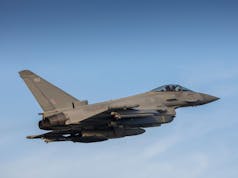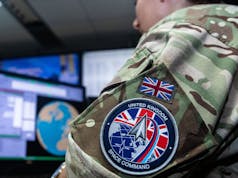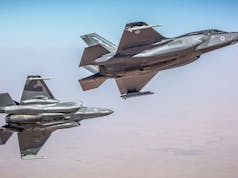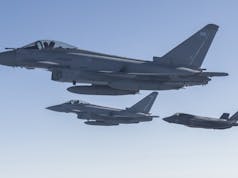A U.S. RQ-4 Global Hawk has temporarily deployed to Royal Air Force Fairford in England, marking the first time this aircraft has been stationed in the UK, according to a press release from U.S. Air Forces in Europe – Air Forces Africa (USAFE-AFAFRICA).
The deployment is part of ongoing efforts to diversify operating locations and strengthen integration with NATO Allies.
The Global Hawk will conduct operations through international and Allied airspace, adhering to international norms and standards. This deployment, the U.S. Air Force say, is also a key step in the implementation of their agile combat employment concept, which allows aircraft to be dispersed from traditional bases to enhance survivability.
The 501st Combat Support Wing at RAF Fairford, which has supported similar deployments in the past, including the operation of U.S. B-52 Stratofortress aircraft for Bomber Task Force 24-3 in June, is supporting this mission.
According to the release, the support and execution of these missions highlight the U.S. commitment to NATO Allies and partners and help establish conditions for future operations within the U.S. European Command area of responsibility.
The RQ-4 Global Hawk is a high-altitude, long-endurance, remotely piloted aircraft with an integrated sensor suite that provides global all-weather, day or night intelligence, surveillance and reconnaissance (ISR) capability.
According to the U.S. Air Force:
“Global Hawk’s mission is to provide a broad spectrum of ISR collection capability to support joint combatant forces in worldwide peacetime, contingency and wartime operations. The Global Hawk provides persistent near-real-time coverage using imagery intelligence (IMINT), signals intelligence (SIGINT) and moving target indicator (MTI) sensors.
Global Hawk is currently fielded in three distinct blocks. Seven Block 10 aircraft were procured, but were retired from the Air Force inventory in 2011. Block 20s were initially fielded with IMINT-only capabilities, but three Block 20s have been converted to an EQ-4 communication relay configuration, carrying the Battlefield Airborne Communication Node (BACN) payload.
Block 30 is a multi-intelligence platform that simultaneously carries electro-optical, infrared, synthetic aperture radar (SAR), and high and low band SIGINT sensors. Block 30 Initial Operating Capability (IOC) was declared in August 2011. Eighteen Block 30s are currently fielded, supporting every geographic combatant command as well as combat missions in Operations Enduring Freedom and Iraqi Freedom/ New Dawn. Block 30s also supported Operation Odyssey Dawn in Libya and humanitarian relief efforts during Operation Tomodachi in Japan.
The system offers a wide variety of employment options. The long range and 30+ hour endurance allow tremendous flexibility in meeting mission requirements. In 2014, an RQ-4 Block 40 flew a 34.3 hour flight, setting the endurance record for longest unrefueled flight by a U.S. Air Force aircraft.”













Just a question… Earlier this week, the UK put a/one or more military satellite/s into space. With satellite coverage, does that not make any kind of airborne surveillance, not obsolete but ‘less necessary’?
I think ISTAR is achieved best by multiple platforms, so no.
All complement.
Satellites have orbits, so an adversary need just wait until the SAT has moved before making a move.
Ok… Thank you DM.
Interestingly, as well as BMEWS, our Fylingdales here acts as a Satellite warning service for defence, to get objects undercover before one passes over.
Also, Satellites can’t Precision strikes like these big Drones can….
Also not same definition
Not all ukraine asks for is declined
Good point on the Geo Stationary. Are they used for surveillance though? I understand that they have limitations.
I don’t mean this as an insult or a dig at you Tom. Over the years that has been the Mantra across parts of the military, politicians and civil servants in nearly every country. When the chips are down and conflict erupts suddenly we find ourselves without the right eyes in the sky. Don’t take my word for it, I would urge you to read. Spies in the Sky. Author Taylor Downing. If you do you will see in every conflict we have gone from zeros to heroes. Then forgot it all only to start again. As an example in the Gulf War it was quickly discovered the coalition had limited quality aerial recce. Step up the Canberra an aircraft in its death throws to save the day. In more recent times the IS fray. Again we were found lacking. Step forward the Tornadoes from RAF Marham and their Raptor Pods. Records were broken for pilot and AC hours and duration. Eight out missions were common place out of Cyprus. Tanking several times Small transit times, so nearly all hours were on task. What did we do then retire them. Madness.
If more proof were needed the US have all but admitted by a paper trail that the Skunk Works are at an advanced stage with what is being referred to as the SR72. A hypersonic child of the SR71.
As Danielle quite eloquently puts. It needs many eyes across many spectrums. You also need the puzzle builders to piece it all together. Like we had at Mednedham at the end of WW2.
I urge you to read the book. Unfortunately it is as true today as it was over the last 100 years we never learn from the past.
Dude… no offence or otherwise taken. It was a genuine question, as I made the assumption that the UK had lots/loads of spy statelites. (assumption being the mother of all -ups)
You are dead right regarding not learning from the past. I will look for that book. ty
£3.09 ebay!
No
Unlikely as only just got CAA clearance to fly in UK airspace. Currently, drones that fly beyond visual line of sight (BVLOS) are not allowed to fly in the UK unless in segregated airspace. There was a recent application for the Global Hawk and now Reaper to do this.
The first of a fleet of 4 MQ4C Tritons has arrived in Australia and is now in service with the RAAF.
The Triton is based on the Global Hawk with similar capabilities but optimized for maritime environments to enable ISR missions including providing weapons grade target acquisition.
The Triton has a more advanced version of Global Hawk’s airframe which can operate in more adverse conditions (anti icing etc.) and has a strengthened fuselage to enable the platform to quickly descend from 50,000 feet to 10,000 feet to monitor targets of interest more closely.
And yes they are big with a wingspan greater than a 737 Max
Not sure…I do not think so.
Reaper we have operated for a decade and one never flew here.
Watchkeeper had to be flown in segregated airspace over SPTA or Cardigan Bay Aberporth ranges.
I’m looking forward to getting a chance to see our Protector, which is cleared to fly in civil airspace unlike the others.
It is easy to forget how big these things are. I remember seeing an MQ-9 up close and thought, bloody hell, its twice the size I expected 🙂
👍